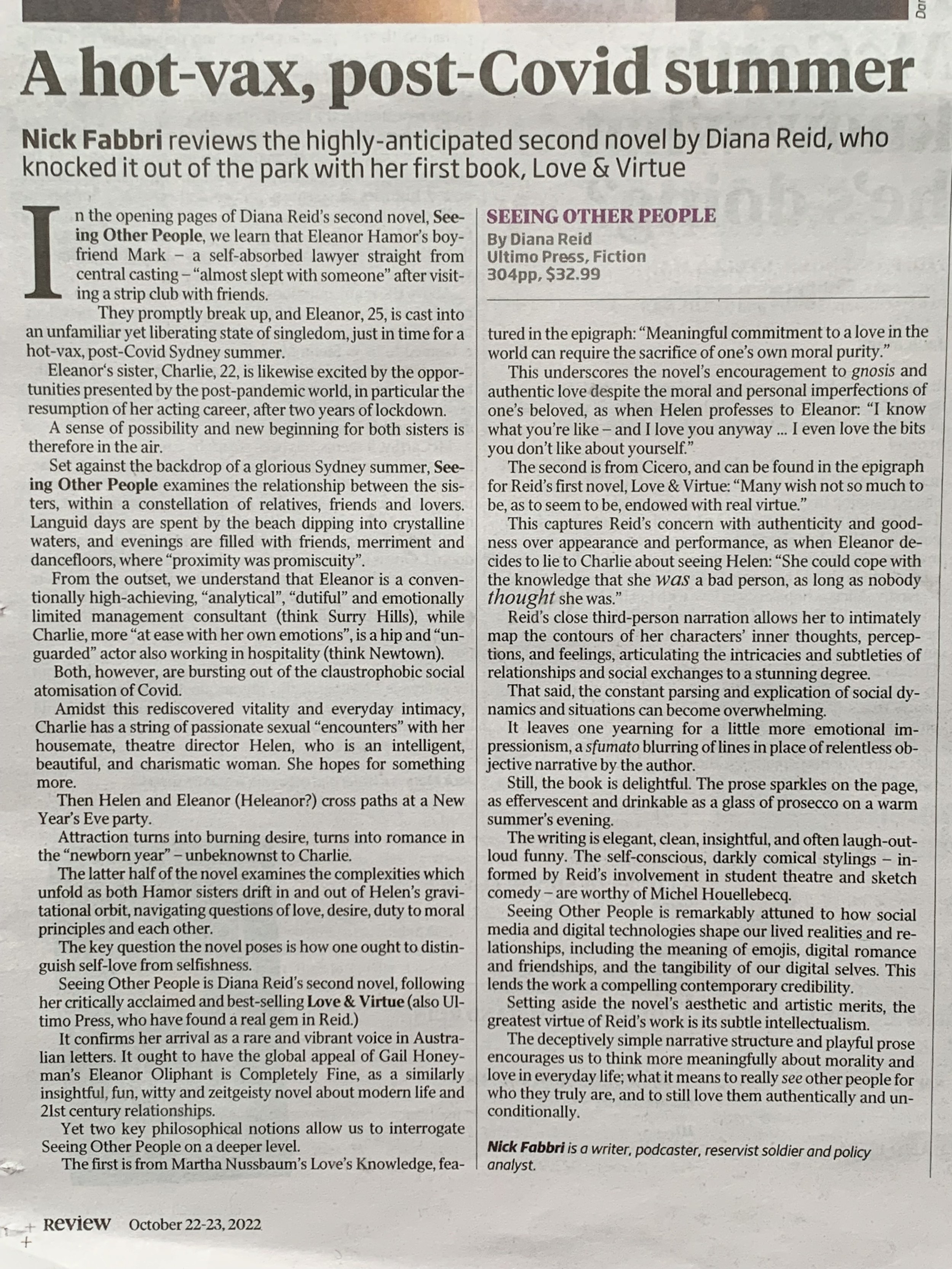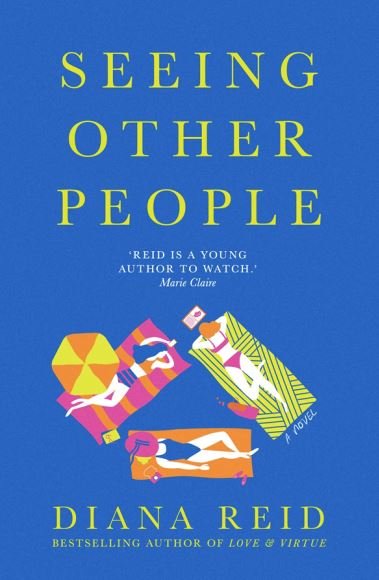This review of Diana Reid’s Seeing Other People appeared in the 22-23 October 2022 print edition of The Weekend Australian. You can view the full newspaper layout via PDF here, with the article also inset below. I’ve also included a longer form review of the novel beneath the newspaper version. You can purchase the book at all good bookstores (I think?), and also via Ultimo Press. Enjoy!
Longer form review
9 October 2022:
Seeing Other People is Diana Reid’s second novel, following her critically acclaimed and bestselling Love & Virtue (Ultimo Press, 2021). It exceeds the high expectations that unduly accompany Sophomore novels and affirms Reid’s arrival as a rare and vibrant voice in Australian letters. The book deserves to become an Australian classic adorning every other beach towel in the coming summer months. It ought to have the global appeal of Dolly Alderton’s Ghosts or Gail Honeyman’s Eleanor Oliphant is Completely Fine, as a similarly insightful, fun, witty, and zeitgeisty novel shining a light on modern life and relationships.
Set against the backdrop of a glorious Sydney summer, with the worst of the pandemic in the rear-view mirror, Seeing Other People examines the relationship of the Hamor sisters amidst a constellation of family, friends, and lovers. Twenty-five-year-old Eleanor is a conventionally high-achieving, “analytical”, "dutiful”, and emotionally limited management consultant (think Surry Hills), while twenty-two-year-old Charlie, more “at ease with her own emotions”, is a hip and “unguarded” actor also working in hospitality (think Newtown). Rather like an Ian McEwan novel, the story is propelled by the repercussions of a catalytic event or moral infraction, like ripples radiating outward from a pebble dropped in a still pond.
In the opening pages, we learn that Eleanor’s boyfriend Mark - a self-absorbed lawyer straight from central casting - “almost slept with someone” after visiting a strip club with friends. They promptly break up, and Eleanor is cast into an unfamiliar and liberating state of singledom just as summer begins. Meanwhile, Charlie’s acting career is getting back on track after two years of lockdowns and industry closures. A sense of possibility and new beginnings quivers in the air.
The writing and pacing of the novel thrum with joie de vivre as the characters burst out of the claustrophobic social atomization of pandemic-induced lockdowns and restrictions. Lives and loves collide in that sacred period over Christmas and New Year’s, where time almost ceases to exist. Languid days are spent by the beach dipping into crystalline waters, and warm evenings are filled with friends, merriment, and dancefloors, where “proximity was promiscuity”. Amidst this rediscovered vitality and everyday intimacy, Charlie has a string of passionate sexual “encounters” with her housemate and theatre director Helen, an intelligent, beautiful, and magnetically charismatic woman, and hopes for something more.
Then Helen and Eleanor (Heleanor?) cross paths at a New Year’s Eve party. Sparks of desire quickly turn into a burning romance in the “newborn year”, unbeknownst to Charlie. The latter half of the novel examines the complexities which unfold as both Hamor sisters drift in and out of Helen’s gravitational orbit, navigating questions of love, desire, duty to moral principles and each other, and what it means to be a good person (and a good sister). The key question the novel poses is how one ought to distinguish self-love from selfishness.
Two key philosophical notions threading throughout Reid’s work illuminate this question and allow us to appreciate Seeing Other People on a deeper level. The first is from Martha Nussbaum’s Love’s Knowledge, featured in the epigraph: “Meaningful commitment to a love in the world can require the sacrifice of one’s own moral purity”. This underscores the novel’s encouragement to gnosis and authentic love despite the moral and personal imperfections of one’s beloved, as when Helen professes to Eleanor: “I know what you’re like – and I love you anyway… I even love the bits you don’t like about yourself”.
The second is from Cicero, found in Love & Virtue’s epigraph: “many wish not so much to be, as to seem to be, endowed with real virtue”. This captures Reid’s concern with authenticity and goodness over mere appearance and performance, as when Eleanor decides to lie to Charlie about her seeing Helen: “she could cope with the knowledge that she was a bad person, as long as nobody thought she was”.
Reid’s sensitive third-person narration allows her to map the contours of her characters’ thoughts and feelings, and to articulate the intricacies of relationships and social exchanges to a stunningly astute degree. That said, the constant parsing of social dynamics and situations can become overwhelming. It leaves one yearning for a little more emotional impressionism, a sfumato blurring of lines in place of relentless objective narrative by the author. Reid is certainly capable of this. Several scenes have resonances with the gentle acuity and emotional sensitivity of Ian McEwan, as the below description of a sunset in late February indicates:
The bridge was a distant coin, like a silver coin half-submerged. And the sky: low clouds at a distance, shot with purple. Everywhere, a gentle, fading pink. It was the sort of view to stretch time. Although it only lasted for a few minutes, it contained all the beauty of a day – of a whole summer.
Or take the scene where Helen and Eleanor first make love:
Helen drew circles in Eleanor’s most private self, adding one finger at a time, then her tongue – wet and eloquent – until Eleanor felt as if her soul – once solid and housed in her brain – was now liquid that trickled beneath her skin, everywhere at once. Then, when she had caught her own breath, Eleanor traced kisses down Helen’s body, each one a poem – not links in a chain, not leading anywhere. Every kiss, every tonguing stroke had its own point. Everything she couldn’t put in words, she put to Helen’s skin.
The inclusion of these vignettes in the latter half of the novel is likely a stylistic technique to demonstrate Eleanor’s emotional flourishing and development after she falls in love with Helen, representing the sublimation of her rational self into a more feeling and emotionally intuitive state of being. But these uncomplicated and unanalysed moments of pure emotion and experience appear too infrequently for how eloquently poetic and moving they are.
Still, the book is a delightful Reid. The prose sparkles on the page, as effervescent and drinkable as a glass of prosecco on a warm summer’s evening. The writing is elegant, clean, insightful, and often laugh-out-loud funny. The self-conscious, darkly comical stylings - informed by Reid’s involvement in student theatre and sketch comedy - are worthy of Michel Houellebecq. Take the scene where Eleanor’s ex, Mark, arrives at an LGBTQIA+ networking function and runs into Eleanor, who is attending at the invitation of her colleague Seb:
Mark met her gaze now with open-eyed surprise. His face was tense, pulled apart by instinct and theory: wanting to assert how straight he was; knowing it was offensive to be so offended. This dance – between the heteronormativity he so valued, and the fluidity he knew he ought to value – played out across his mouth, which wobbled and tripped through several false starts.
Seeing Other People is also remarkably attuned to how social media and digital technologies shape our lived realities and relationships, including the meaning of emojis, digital romance and friendships, and the tangibility of our digital selves. It seamlessly captures the ways our existence is, sometimes disturbingly, intertwined with our phones – as when Eleanor “physically ached to reach for her phone”, or how we are told Charlie was “intimately attuned to the rhythms of her phone”, able to distinguish between “the short vibration for email; the longer hum of a text”. Or consider the ways in which we glean lapidary details about our friends and lovers through their digital selves – as when Eleanor trawls through Mark’s tagged Instagram photos, and the accounts he followed to find “evidence – a photo, a new contact – of what happened the night that Mark betrayed her”.
The novel also deftly depicts, in both form and substance, the various ways in which digital communications convey meaning, emotion, and desire in modern communications and relationships– the “unopened message from Helen still flirting on the screen – wyd tonight?”; the import of leaving people on read or seen; the communicative nuances of reactions to messages and stories: love-hearts, sad, surprised, and laughing reacts; the anticipation of watching “the three dots dance” when a message is being composed; how receiving a notification or message from a crush can make you “feel like a plucked violin string”; or the dopamine rush one gets from seeing someone you’re interested in like your posts. All of this lends the work a compelling contemporary credibility. Reid also beautifully captures the tonalities of different pockets of Sydney, including “bus-exhausted King Street”, the effortless and “salty” January days by the eastern beaches, or the way one feels “cheated” when it rains in Sydney: “the city didn’t suit the grey. It looked abandoned: like a failed project.”
Given her youth, it’s tantalising to think of the works within Diana Reid still to be written, and the myriad ways she will continue to reflect life back to us as her craft develops. Setting aside the novel’s aesthetic and artistic merits, the greatest virtue of Reid’s work is its subtle intellectualism. The deceptively simple narrative structure and playful prose encourage us to think more meaningfully about love and morality in everyday life, and about what it means to really see other people for who they truly are, and to still love them authentically and unconditionally.

